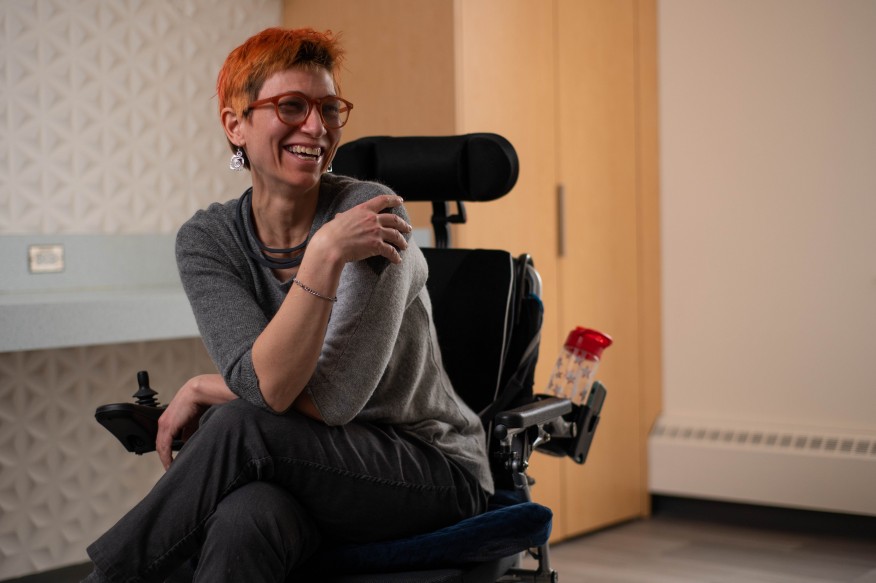-
Pathway:Interpersonal Practice, Community Change
“I have always been on the same ship,” says MSW student Gwynneth VanLaven. “I have just steered in different directions.”
VanLaven got her start in a Quaker community in Pittsburgh, where her parents engaged in social justice and community building and helped with the group’s food cooperative. Her parents then moved to the Northern Virginia/Washington D.C. area. She attended Knox College in Galesburg, Illinois.
There VanLaven created her own major — Multimodal Language, Verbal, Visual and Kinesic Systems — which drew on dance, visual art and modern languages, and explored what VanLaven calls the “glamorous syntax” of visual and kinesic languages. (Kinesics is the study of body movement and gesture as nonverbal communication.) “I knew I wanted to build bridges,” she says. “I found that art was the richest, most delicious way to do that.
I found the U-M School of Social Work to be in alignment with the way I had experienced community. Community and interdependence are embodied in the program. When I bring up disability justice, my classmates are like sponges; they are so primed, it’s great.
“I was also interested in rabble-rousing,” she adds, “the social justice advocacy aspect of art.” She found a multimodal, interdisciplinary master’s program, Critical Art Practices, at George Mason University, in Fairfax, Virginia. By now VanLaven was clearer than ever on what the arts meant to her.
“I wanted to use art as an entry point into the psyche,” she says. “I had a lot in my own psyche that I needed to deal with. I grew up with chronic pain and a cluster of misunderstood, even undiagnosed illnesses. I am driven to express the intensity, the flavor of pain that I experience, and I am driven to use storytelling to connect with people. I have always sought language that is specific, poignant and salient to personal experience, and that is elegantly and efficiently directed to that experience.”
VanLaven found empowerment in joining the National Organization for Rare Diseases and becoming a patient advocate. “Knowledge and self-advocacy is imperative when dealing with rare diseases in our troubled system,” she says. She drew — or perhaps rabble-roused — support from clinical trials at NIH and elsewhere, a coordinated care model at the Mayo Clinic and a network of doctors from many institutions. Some of VanLaven’s doctors even became collaborators in her art practice, which has included visual art, writing, dance and clowning. (Her work has been featured in the Washington Post and at the Smithsonian and the Kennedy Center, among other places.)
“Playfulness around difficult or awkward topics has been key to my healing,” she says. “I practice movement for joy and community, not just pain. I bring inclusivity and accessibility and I dialogue with ableism, mental health stigma and othering. Play can be safely, deliciously awkward, richly embodying and co-creative.”
In 2007, VanLaven suffered further injury when an automobile crushed her against a building. “It's been a long road of recoveries,” she says. Beyond coping day-to-day (she uses a wheelchair and sometimes a cane or walker), her first instinct was to share the experience. “Sharing the complexity and intensity — and have someone hold that — is the crux of being human,” she says. “From that perspective, social work makes a lot of sense for me.”
The University of Michigan also made sense. VanLaven had come to Ann Arbor in 2015 to be with family. “I found the U-M School of Social Work to be in alignment with the way I had experienced community,” she says. “Community and interdependence are embodied in the program. When I bring up disability justice, my classmates are like sponges; they are so primed, it’s great.”
VanLaven mentions that her favorite teachers have been “wonderfully rigorous.” “Our first segment was on suicide assessment. I was uncomfortable, but I love to be uncomfortable. It prepares you to empathize with clients.” In her social justice class, VanLaven created a book of songs her mother had sung in reaction to social ills (including “This Little Light of Mine” and “I Am Woman”). “Doing that book,” she says, “combined with written vignettes and broader contexts I was learning in class, I thought: This is where I want to be.”
The School’s Self-Healing and Social Justice Art Collective has captivated VanLaven. “The collective is a shining beacon,” she says. “It thrills me that the School values multimodality and the arts.” VanLaven has also continued to make new art during her time at the School. She facilitates for InterPlay, a community play group in Ann Arbor, and DanceAbility, an inclusive movement program in Detroit.
Planning her future, VanLaven says, “I want to do interpersonal therapy in a way that is sustainable for a person with a disability. I want to help those who have experienced disembodying events like trauma or chronic pain or illness or body shaming. I will use play, dance and art to help them build whatever they need.”
This, then, is where the ship has always been going. Teacher, student, therapist, performer, artist and writer. In all her roles, the universe has had one message for Gwynneth VanLaven: “Sail on!”
To learn more about VanLaven’s art and advocacy, visit www.vanlaven.art.
